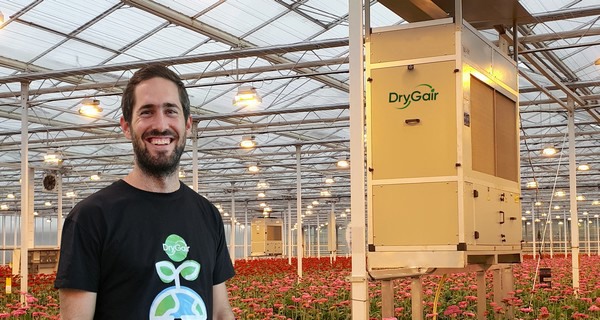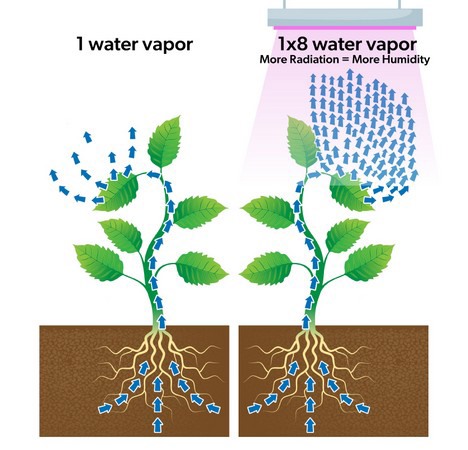“Lights have a major impact on greenhouse humidity. When adding lights or changing the type of lighting, it’s important to consider how it will affect humidity. In most cases, it’s necessary to increase your dehumidification capacity to compensate for the extra moisture.” According to Kandlik.
“When combined effectively, lighting and dehumidification can significantly improve growth, improve yields, and save energy.”
How does lighting affect humidity?
“Light affects transpiration in 2 ways – radiation and heat. Radiation is what plants need in order to photosynthesize. So when the lights are on, the plants respond by opening their stomata, increasing their ability to absorb air.” Amir says.
“However, when the stomata are open, water evaporates. So higher radiation intensity, or longer lighting hours, will lead to higher evaporation rates, pushing humidity in the greenhouse upwards.

It’s also important to consider the quality of the light spectrum and not just intensity. Mainly the relationship between red and blue light. LED lights, for example, contain more of the blue side of the light spectrum compared to HPS lights. It’s been shown in studies that blue light has a greater impact on the stomata, increasing transpiration more than other lights.
So even if you’re just changing the type of lighting you use, it’s still important to understand how much of an effect it will have on humidity.
The second effect light has on transpiration is through heat.” Kandlik continues. “a warmer environment leads to more evaporation, up to a certain degree.”
All lights emit heat, even the most efficient LED lights. There’s a misconception that LED lights don’t raise the temperature. But when there are a lot of powerful lights, as is the case in most greenhouses, they actually contribute a lot of heat. This also increases transpiration substantially.”

Dehumidification perfectly complements extra lighting
“Increasing the amount of light in a greenhouse, without increasing your dehumidification capacity, will inevitably lead to high humidity,” says Kandlik. “Of course, high humidity leads to problematic disease and mildew outbreaks.
But it’s not just about preventing diseases. Reducing the relative humidity level increases the gains you can get from the added radiation, making lights and dehumidifiers the perfect combination.
Plants will only be able to increase their photosynthesis rates if the environmental conditions allow it. When the environment is humid, plants can’t transpire, meaning they struggle to take in and transport nutrients and CO2. So even with the extra light, you may see less growth, as the crops aren’t able to function effectively.”
Plants photosynthesize less in dry conditions, so how can dehumidification improve photosynthesis?
“That’s a good question. It’s true that plants won’t photosynthesize properly when it’s dry, as the stomata close to prevent water from evaporating. But that’s not the case here.” Kandlik explains, “First of all, dehumidifiers are primarily meant for nighttime control in greenhouses, and photosynthesis doesn’t occur in the dark. Besides, even with dehumidification running all day, you would still expect around 70%-80% relative humidity because the plants provide a lot of moisture. That’s a perfect humidity range to allow ideal photosynthesis.
In greenhouse cultivation, there’s a different limiting factor – carbon dioxide. Along with radiation, CO2 is necessary for photosynthesis. More light will only increase photosynthesis if CO2 levels are high enough to allow it.
That’s another benefit you get from using dehumidifiers.” Kandlik says. “Overnight, plants don’t absorb CO2 but emit it. So, by keeping the greenhouse closed, you can increase carbon concentrations early in the day, providing a boost to photosynthetic activity. Without dehumidification, this wouldn’t be possible. Humidity would quickly rise too high, forcing you to ventilate and lose the extra CO2.”
Find the perfect balance between lighting and dehumidification
Kandlik summarizes, “At the end of the day, it’s all about finding the right energy balance. Proper planning, considering the effects of additional lighting on humidity, and adjusting dehumidification accordingly, will provide the best results.
Adding lights to your greenhouse is a great way to improve growth if done right. Combining lights and dehumidifiers is the perfect way to gain better control over your environment, improve growth and save energy in the process.”
For more information:
DryGair Energies
8 Hamanofim St, Herzliya
T: +972-9-7730989
www.drygair.com
